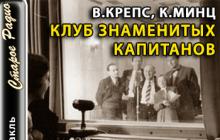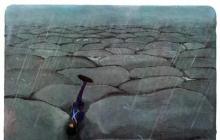These lands were inherited by Golitsyn's grand-nephew Dmitry Trubetskoy. In 1758 new owner built a wooden one-story house here. Behind him stood a greenhouse, and then a park with gazebos, garden ideas and two ponds began. One of them had a complex shape, which became the reason for talking about secret Masonic signs.
Trubetskoy was a hospitable owner, so many famous people visited his estate. For example, on September 16, 1826, returning from festive festivities on the Devichye Pole on the occasion of the coronation of Nicholas I, Alexander Pushkin visited the estate.
In 1923, the Trubetskoy estate was turned into a Mandelstam park for workers' recreation. The name was given in honor of the revolutionary Alexander Mandelstam.
In 1936, the first children's park in Moscow appeared here. During the Great Patriotic War, an anti-aircraft battery and a repair shop were placed on its territory. military equipment... Because of this, trees had to be cut down.
In 1945-1960, a station for young naturalists worked here. Through their efforts, Mandelstam Park was revived. These traditions continue: there is a poultry house, a menagerie in the park, child Center, an ecological path with rare plant species (planted in the middle of the 19th century by the pharmacist A. Grell and the followers of IV Michurin).
The main house of the Trubetskoy estate has not survived. After the fire in April 2001, the building was "recreated in non-combustible materials": they dismantled to the basement and put a concrete "remake" in its place.
Only a few artificial ponds remain from the estate itself. There is in the park an ambiguous monument "The Tree of Love" by Grigory Pototsky. The sculpture is created in the form of two merged figures of a girl and a boy, spreading arms-branches, which either turned into wings, or into the Tree of Life. Some believe that these are the profiles of Adam and Eve. Others see angels in the composition. And some even consider the sculpture to be a natural monument.
In 2002, Mandelstam Park was restored. Wooden fairy-tale sculptures were installed there, and it turned into a children's park. Therefore, the park of the Trubetskoy estate in Khamovniki is open to the public only during the day.
Mandelstam Park in photographs from different years:
Do you have anything to add to the history of Mandelstam Park with the Trubetskoy estate in Khamovniki?The Trubetskoy estate is a small park where you can come with your children and be sure that they will like it here. There are many attractions in the park, there are exciting activities for curious and active children.
The history of the park began in the 17th century, when the allotment of land on which it is currently located was presented to Prince Golitsyn for special services to the Motherland.
Over the years of its existence, the estate has belonged to many famous people: revolutionaries, philosophers, generals. During the years of Soviet power, Moscow schoolchildren worked on the improvement of the park. All the trees here are planted by their hands.

But, of course, the younger generation is not interested in history, but in the opportunity to have fun and carefree time. Various playgrounds for games and recreation await children and their parents: the playground of Faithfulness, Pushkin, Love, Friendship.
Walking along the narrow paths, you can find unusual sculptures, the Dwarf Corner, the Road of Dreams and even the Enchanted Island in the pond.

For active rest in the park there are:
- Numerous circles of children's creativity;
- Biological station with a zoo;
- Sports ground with a lot of shells and attractions;
- Horse riding school;
- Children's television studio;
- Toddler entertainment center;
- Greenhouse with a collection of unusual plants.


The Trubetskoy Manor Park in Moscow is perfect for family vacation... Parents can take a break from the hustle and bustle, enjoy the architectural heritage and touch the history. The younger generation will happily play with their peers, discover a lot of new and interesting things - fortunately, today they carefully monitor it, update it and modernize it so that the rest is full and carefree.
Behind the Khamovnichya settlement. He, in turn, presented it as a gift to his sister - the wife of Yuri Petrovich Trubetskoy. In 1758, under Nikita Yuryevich Trubetskoy, the main house was erected in the estate - a small palace with a belvedere. There were other buildings nearby: gazebos, two ponds with islets and rotundas, and around a magnificent garden. In the 19th century, the Trubetskoy estate in Khamovniki could claim to be a center cultural life Moscow. It was often visited by writers, scientists, philosophers and other prominent figures of the country, but to late XIX centuries the estate began to be sold. The merchant Pavel Evstafievich Nemchinov became the owner of the estate. He stayed them up to a year.
After the revolution
The civil war caused great damage to the estate. The trees of the lush garden turned to dry land, and heaps of rubbish appeared. In 1923, by the decision of the district party committee, the former Trubetskoy estate in Khamovniki became a place of cultural pastime for workers. Its name also changed: Soviet workers came to rest in Mandelstam Park, named after the revolutionary A.V. Mandelstam. During subbotniks, residents of the city put the territory in order. There were rides, a cinema, a shooting gallery. We can say that Moscow, Khamovniki and the former princely estate gave our country the "progenitor" of modern parks of culture and recreation.
The emergence of a children's park

In 1936, the history of this place received a new round of development. The first children's park in the capital was opened here. It was considered one of the best green areas in Moscow. Children spent time on playgrounds, a boat dock, a children's theater, a fishing club, a sports town and even a parachute tower were equipped.
However, the Great Patriotic War made its own adjustments to the development of the park. The trees were almost completely cut down. They were replaced by an anti-aircraft battery and a workshop for the repair of military equipment.
In the post-war years she worked here city station young naturalists. With the help of all schoolchildren in Moscow, trees were planted again from 1945 to 1960, which now adorn the capital. By the way, modern park The Trubetskoy estate in Khamovniki almost completely repeats the scheme of the princely estate of the 18th century. Paths, alleys, plantings and flower beds are located in the same way.
After the closure of the station during the restructuring period, wooden elements gradually deteriorate, and by 1992 only a greenhouse and a change house remained on the territory of the park, in which circles of naturalists and a zoo corner were located.
Revival
Naturally, this could not continue. The issued law "On Education" raised the question of the need to restore the park and its role in

In 2002, the structure of the park was reorganized. It has included in its structure a children's and youth center with an equally glorious history. Previously, it was the first House of Pioneers in Russia, which did not stop working even during the Second World War. He united hundreds of children who, at that difficult time, helped the soldiers to the best of their ability: they sewed mittens, pouches, handkerchiefs for them, arranged concerts, were on duty at home and even extinguished "lighters". Over the years of its existence, the House of Pioneers has received many awards and certificates. Now it is which is combined with such a place as the children's park "Trubetskoy Estate in Khamovniki", and, by the way, has the same name.
Associations and studios
Here children are offered various options for additional education. Any child can find something to their liking. Parents can send their child to artistic and aesthetic circles: ballroom dancing, choral studio, computer graphics and web design, ceramics, fine arts, beading, theater studio ...
Ecological and biological circles teach children to interact with the surrounding nature, see its beauty, and preserve it for the future. Young talents can take up woodcarving, and at the same time get to know their park. The estate (in the broadest sense of the word) becomes the subject of study for the children. They get acquainted with her life, traditions, architecture, handicrafts of young masters often participate in exhibitions and competitions.

The floristic studio teaches not only the art of arranging bouquets, but also gives knowledge about color and design, ecology and geography. The Trubetskoy Manor in Khamovniki Children's Park also boasts its own equestrian club Triglav. Pupils of the club learn to ride and take care of horses. They participate in competitions and theatrical performances, in the summer they leave for the camp with their pets. Ordinary vacationers can watch the horses ride from the tribune. Even preschool children come to the territory of the Triglav club with pleasure to take a closer look at the graceful handsome men and treat them with something tasty.
On the territory of the park there is an association "Young Cynologist". Children 12-17 years old visit it. They get acquainted with various breeds of dogs, learn to handle them, and not only in theory, but also in practice, get training skills. There is a separate area for walking dogs equipped with special exercise equipment.

For health and relaxation
Park "Manor Trubetskoy" regularly holds all kinds of holidays and games, to take part in which invites everyone. These can be days dedicated to birds, land, water, environmental protection, children's drawing contests or handicrafts made from natural materials.
The tourist club regularly organizes hiking, sailing or skiing trips, rafting on mountain rivers, historical excursions, not only in Moscow and the region, but throughout Russia and abroad.
Of course, physical development is very important for the health of the younger generation, therefore it is quite natural that football, aikido, volleyball, fitness, sambo, sumo sections function in the park. Rewarding of those who distinguished themselves in the competition takes place on the Alley of athletes. It also hosts relay races for toddlers, the traditional "Manor Track" competition for the whole family, and the "Manor Mile" cross-country race for children of all ages.
Where to visit and what to see

The area of the park itself is 10 hectares. This area has many picturesque corners with romantic or funny names: Dream Trail, Mysterious Alley, Fantasy Trail, Enchanted Island ... For young visitors there are two playgrounds with soft surfaces so that young explorers can travel without obstacles and scratched knees. For the most active there is a rollerdrome. Competitions are often held on the equipped track. The Safe Trail is interesting, where young visitors are taught to provide first aid. In winter, children strive with great pleasure to the Tsar Mountain, to feel how the wind whistles during a rapid descent.

Our smaller brothers
The Trubetskoy Manor Park in Khamovniki also has its own small zoo. Squirrels live in enclosures. For those who want to feed them, a special plate is installed with an indication of their favorite delicacies: honey, cottage cheese, jam. However, there is a warning that sticking fingers into the cage is not recommended, because it is fraught with injuries. But it is strictly forbidden to feed the fish in the pond. In the poultry house you can see budgerigars, Indo-ducks, lovebirds, geese, pheasants and, of course, chickens.
Behavior rules
The park is well looked after, and the guards are careful to keep order. Since this is a place for children and families, alcohol and cigarettes are strictly prohibited here. By the way, events dedicated to the prevention of alcohol, drug and nicotine addiction are regularly held here. Young mothers with strollers prefer the children's park during the obligatory walks with the baby, because the beautiful nature, the amazing combination of antiquity and modernity, clean air and the absence of "suspicious personalities" create excellent conditions for relaxation.

There is one more thing in this remarkable place- Museum-Estate "Khamovniki". This house was built in Dolgo-Khamovnichesky lane from 1800 to 1805. It is famous for the fact that in 1882-1901 Leo Tolstoy spent his winters here with his family. Significant events for him took place here and about a hundred of his creations saw the light of day: "Resurrection", "Living Corpse", "Kreutzer Sonata", "Answer to the Holy Synod" were born here.
The museum covers an area of 442.7 m 2. Around there is a garden, where there is a fill slide, a gazebo and a well. The street on which it is located is now named in honor of the great writer - Leo Tolstoy.
Children's park "Estate of the Trubetskoy in Khamovniki"(popularly - Mandelstam Park)- a small (~ 10 hectares) park near Komsomolsky Prospect, formed on the territory of an old noble estate.
A distinctive feature of the park is a picturesque manor pond, from which a winding ring of canals departs. Channels form on the pond big Island- Enchanted island; You can get to it along two graceful and light pedestrian bridges: Gorbaty and Straight. The canal system and beautiful bridges are reminiscent of Dutch ponds in , which also arose on the site of an old estate, thanks to which the parks are associated with each other and with Moscow history.
"The Trubetskoy estate in Khamovniki" is a children's park, the space of which is organized according to the plan: there are several thematic playgrounds on the territory ("Lukomorye", "Labyrinth", " Fun slides"," Jungle "," Gnome "), a poultry house and a squirrel house (practically a mini-zoo), Tsar-Hora for winter skiing and other locations with an emphasis on the" children's "theme. The same approach is used in the names of the alleys: Alley of fairy tales, Alley creativity, Mysterious alley, Path of fantasies, Path of surprises, Path of dreams, Path of discoveries and others; the central alley of the park bears the historical name - Trubetskoy Alley.
For environmental education of visitors, an ecological path has been laid on a separate area of the park. In addition, the park has a mini-stadium with football, basketball and volleyball fields and a dog playground.
The history of the park and the Trubetskoy estate in Khamovniki
The estate dates back to the end of the 17th century, when a courtyard with a garden on Devichye Pole was granted from the Zemsky Prikaz to Vasily Golitsyn. In 1758, Golitsyn's grand-nephew Nikita Trubetskoy, who received a courtyard through a chain of inheritance, built a wooden manor house with a belvedere and a greenhouse here. During his reign, 2 ponds were dug here: one rectangular, the second of a complex shape, into which several islands were inscribed. Rotunda pavilions were located on the islands, and a garden was laid out around the ponds.
In the middle of the 19th century, the estate, once again passed through the chain of inheritance, was sold out in parts.
In 1923, the new government decided to organize a park for workers' rest on the site of the garden; the park was created at the expense of local factories and factories, as well as the workers themselves, and as a result, on the basis of the estate garden was formed Working garden named after A.V. Mandelstam(Alexander Mandelstam is a Russian revolutionary and publicist, not to be confused with the poet Osip Mandelstam), which was equipped with recreation and sports grounds, a shooting gallery and a stage.
In 1936, the Workers' Garden lost its relevance, and on its basis they decided to equip the first children's park in Moscow, designed to solve the problems cultural recreation, studying nature and sports training of children from birth to graduation. A children's theater was equipped here, playgrounds, a car park, a boat dock and a corner for amateurs-anglers, attractions and sports grounds.
After the collapse of the USSR, the park as a whole fell into decay. In 2001, the manor house burned down; the originally lost monument was planned to be recreated in non-combustible materials, but in fact a remake was erected in its place, completely different from the original building.
Today the park is qualitatively landscaped, but, by and large, it is not much different from many other city parks.
Park "Estate of the Trubetskoy in Khamovniki" - perfect place for relax. Planted with old poplars, lindens and birches, it has become a cozy green corner next to the noisy Komsomolsky Avenue.
The picturesque park pond and winding canals will surely appeal to photographers, and ordinary citizens will find something to do: they have sports grounds, walking alleys and, of course, a living corner at their service. The concert venue hosts city holidays and various performances for children and adults.
The park is located in the Khamovniki district near Komsomolsky Prospekt and the Moscow Youth Palace. You can get to it on foot from the metro station "Frunzenskaya" Sokolnicheskaya line.



